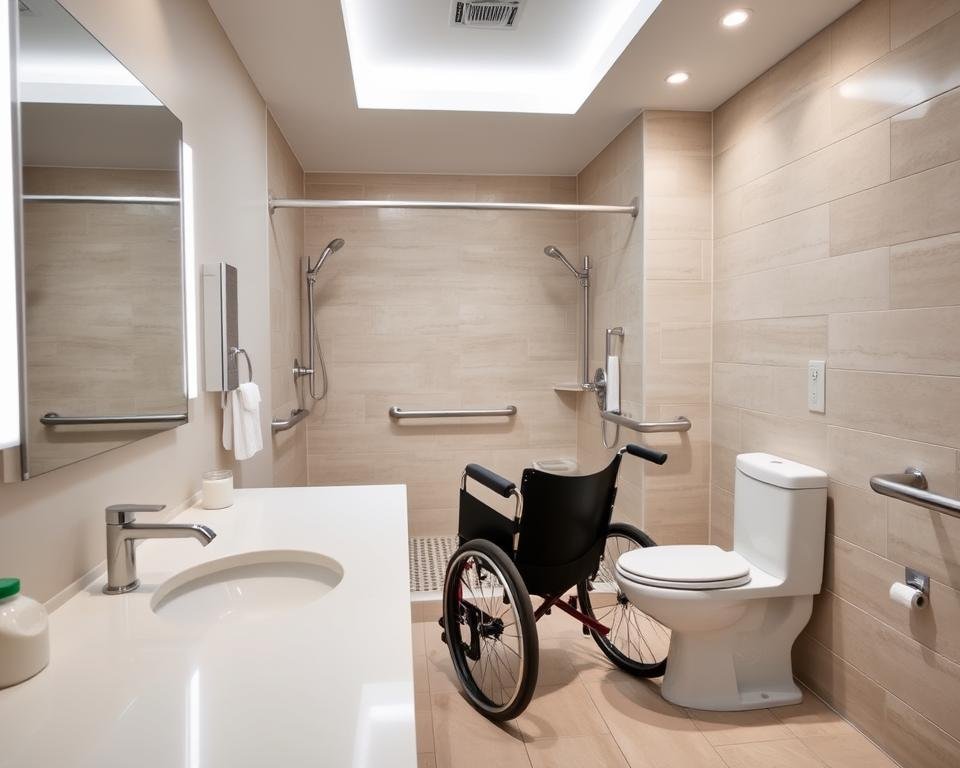“The ache for home lives in all of us, the safe place where we can go as we are,” poet Maya Angelou once wrote. This timeless truth resonates deeply when creating spaces that adapt to life’s changes. Designing a residence that supports independence while aging doesn’t mean sacrificing style—it’s about blending practicality with warmth.
Imagine a living environment where every detail works for you. Simple upgrades like grab bars in bathrooms or slip-resistant flooring can prevent accidents without looking clinical. These changes aren’t just functional—they empower you to thrive in a space tailored to evolving needs.
But it’s not just about safety. Forward-thinking design considers comfort and accessibility. Wider doorways, lever-style handles, and adjustable countertops ensure daily tasks stay manageable. The best part? These features can seamlessly integrate into your existing décor.
Think of it as future-proofing your sanctuary. By addressing potential challenges now, you preserve the value of your property while prioritizing well-being. After all, a thoughtfully designed space lets you focus on what matters most: living life on your terms.
Key Takeaways
- Smart updates like grab bars and non-slip surfaces enhance safety without compromising style.
- Design choices today can prevent costly modifications later as needs change.
- Accessible features blend naturally with modern aesthetics when planned thoughtfully.
- Aging in place requires balancing immediate comforts with long-term functionality.
- Proactive renovations maintain property value while supporting independence.
Understanding the Need for Age-Friendly Home Modifications
Did you know 77% of adults over 50 want to stay in their current residence as they grow older, according to AARP? This desire for familiarity drives the demand for practical updates that keep spaces safe and comfortable. Simple changes today can prevent life-altering accidents tomorrow.
Enhancing Safety and Accessibility
Slippery floors and cramped showers account for over 80% of bathroom-related injuries among older adults. Swapping glossy tiles for textured surfaces reduces slip risks by 71%, per NAHB research. Curbless walk-in showers with built-in seating aren’t just trendy—they eliminate tripping hazards while offering easier access.
Promoting Independence with Home Modifications
Strategic upgrades let you maintain daily routines without relying on others. Lever-style door handles require minimal grip strength, and motion-activated lighting guides nighttime movement safely. These adjustments cost 65% less than annual assisted living fees, making them a smart financial choice.
For families considering shared spaces, multi-generational households benefit from wider doorways and adjustable countertops. These features accommodate varying mobility needs while keeping your house welcoming for all ages.
Designing with Universal Accessibility in Mind
Universal design isn’t just a trend—it’s about creating spaces that work for everyone, today and tomorrow. By focusing on flexibility and ease of use, you ensure every family member feels comfortable moving through daily life. Let’s explore how thoughtful layouts and smart features build safety into your environment naturally.

Wide Doorways, Open Spaces, and Safe Staircases
Doorways measuring at least 36 inches wide accommodate wheelchairs and walkers effortlessly. Open floor plans reduce tripping hazards while making rooms feel airy. For stairs, install double handrails on both sides—this provides stability whether ascending or descending.
In the bathroom, proper grab bars need secure mounting. Anchor them to wall studs using corrosion-resistant screws. Pair these with slip-resistant flooring to create a safer bathing area. Did you know textured tiles reduce fall risks by 34% compared to smooth surfaces?
Lighting matters too. Motion-activated fixtures in hallways and near stairs prevent missteps after dark. These small changes enhance care without disrupting your space’s aesthetic flow.
Thinking ahead means choosing features that adapt as needs evolve. Lever-style faucets and rocker light switches require minimal effort to operate. By embedding these elements now, you’ll save time and stress later—proof that good design truly stands the test of time.
Top Home Renovation Ideas for Aging Seniors
What if your space could protect you while looking effortlessly stylish? Strategic updates create safer environments that support your health without feeling institutional. Let’s explore practical changes that blend safety with everyday convenience.
Bathroom Upgrades: Grab Bars and Curbless Showers
Bathrooms pose the highest fall risk, but smart renovations can change that. Install grab bars near toilets and showers—they’re now available in sleek finishes matching modern fixtures. Curbless showers eliminate tripping hazards and simplify wheelchair access when needed.
Choose textured flooring to prevent slips, even when wet. Antibacterial grout reduces mold growth, protecting respiratory health. These updates take little time to install but offer years of safer use.
Kitchen and Living Area Adaptations
Adjustable countertops let you prep meals seated or standing. Under-cabinet lights brighten workspaces without glare—a game-changer for evening tasks. Swap knobs for lever handles on cabinets; they’re easier on arthritic hands.
In living rooms, motion-sensing lights illuminate pathways after dark. Furniture risers create comfortable seating heights, while removing area rugs reduces trip risks. These options maintain independence while keeping spaces inviting.
By addressing needs now, you’ll avoid costly changes later. Thoughtful renovations preserve your property’s value while prioritizing your well-being—a win-win for today and tomorrow.
Budget-Friendly and Cost-Effective Home Upgrades
Did you know the average assisted living facility costs $4,500 monthly, while most safety upgrades cost less than a year’s worth of those fees? Smart investments in your residence today can save thousands while keeping your independence intact.
Exploring Financial Assistance Options
Medicare Advantage plans now cover some accessibility modifications, and HUD’s Section 504 grants offer up to $7,500 for qualifying households. Many states provide low-interest loans specifically for safety upgrades. Key programs include:
- Veterans’ Home Adaptation Grants (up to $21,000)
- Property tax deferrals for accessibility projects
- Nonprofit partnerships offering free labor for installations

Comparing Renovation Costs and Long-Term Savings
Widening doors averages $1,200—equivalent to just 10 days in assisted care. Adjustable countertops ($2,500) create meal prep ease for decades. Consider these impactful changes:
- Bedroom layout adjustments ($800) improve nighttime mobility
- Non-slip flooring ($3/sq.ft) prevents 73% of common falls
- Motion-sensing lights ($40/unit) reduce energy use by 30%
These options adapt to your changing needs over time. By focusing on high-impact areas like doors and bedroom flow, you create lasting value. Remember: every dollar spent on prevention saves $4 in future healthcare costs, according to CDC data.
Your living space should evolve with your life. With the right options, you’ll maintain comfort without compromising financial security—a true investment in your future.
Integrating Smart Home Technology for Safety and Comfort
Your living space can now anticipate your needs before you even realize them. Modern tech solutions blend seamlessly into daily routines while providing peace of mind. From voice-activated controls to systems that learn your habits, these innovations create safer environments without sacrificing convenience.
Automated Lighting and Remote Monitoring Solutions
Motion-activated lights illuminate pathways when you enter a room—no fumbling for switches. In the kitchen, under-cabinet LED strips brighten countertops automatically during meal prep. These systems use 75% less energy than traditional bulbs while reducing accident risks.
Smart sensors in closets trigger tap lights when doors open, making it easier to find items. Remote monitoring lets you check security cameras or adjust thermostats from any device. For people with limited mobility, voice commands control lights, locks, and appliances effortlessly.
Research shows automated systems reduce nighttime falls by 43% by eliminating dark zones. Customizable settings adapt to your unique needs, whether you prefer gradual brightness changes or instant illumination. Best of all, installation takes hours—not days—and integrates with existing wiring.
These upgrades prove technology isn’t just for tech lovers. By simplifying daily tasks, smart features let you focus on what matters most: enjoying your space with confidence and ease.
Customizing Spaces: Kitchens, Bathrooms, and Bedrooms
Your favorite rooms deserve to grow with you—not against you. Thoughtful adjustments in key areas create environments that support independence while reflecting personal style. Let’s explore how to optimize these spaces for both safety and daily joy.

Kitchen Modifications for Ease of Use
Adjustable countertops let you prep meals seated or standing. Pull-out shelves bring items within reach, eliminating awkward stretching. Swap round knobs for lever-style handles—they require 80% less grip strength, according to ergonomic studies.
Under-cabinet lighting brightens workspaces without glare. Pair this with touch-activated faucets to simplify cleanup. These changes address common issues like limited mobility while keeping your cooking area functional.
Bathroom Accessibility and Safety Upgrades
Curbless showers with built-in seating reduce fall risks by 52%. Install grab bars near toilets and tubs—modern designs now mimic towel racks for discreet safety. Textured flooring provides traction even when wet.
Raised toilet seats and hands-free sinks make daily routines smoother. These home modifications blend seamlessly into your decor while offering crucial support for aging place preferences.
Bedroom Layouts for Comfort and Functionality
Keep pathways clear with furniture that hugs walls. Bed risers adjust height for easier sitting or standing. Nightstands with charging stations reduce cord clutter—a tripping hazard many overlook.
Motion-sensor lights guide nighttime movement safely. Position outlets 24 inches above floors to avoid bending. These tweaks give loved ones confidence in your daily comfort while preserving your space’s cozy vibe.
Planning for the Future: Long-Term Home Adaptability Strategies
Designing a space that evolves with you requires foresight and smart choices. Universal design principles aren’t just about accessibility—they’re investments in your quality of life. Research shows 68% of seniors who make proactive modifications report greater confidence in maintaining independence.
Building Flexibility into Every Detail
“Good design anticipates needs before they become urgent,” notes architect Sarah Thompson. Start with flooring—textured surfaces reduce fall risks while complementing modern interiors. Cork and rubber options offer cushioning for joints and last 3x longer than traditional materials.
Consider these adaptable upgrades:
- Wall reinforcements behind drywall for future grab bar installation
- Adjustable-height shelving systems in kitchens
- Electrical outlets placed 18-24 inches above baseboards
Strategic remodeling costs 22% less when integrated during initial projects. For example, widening doorways during routine updates adds $300-$500 versus $1,200+ later. This approach maintains your space’s flow while preparing for mobility changes.
Balance immediate cost with lasting value: non-slip tiles might cost $4/sq.ft but prevent $30,000+ in medical bills from falls. By blending practicality with style, you create environments that support every chapter of life—without constant overhauls.
Conclusion
Creating a space that grows with you starts with smart choices today. Thoughtful changes like better lighting and wider doors aren’t just about safety—they’re about preserving your independence while keeping your environment welcoming.
Projects that prioritize security and mobility—such as motion-activated lighting solutions or reinforced doors—make daily life smoother for everyone. These features blend seamlessly into your existing layout, proving practicality doesn’t require sacrificing style.
By focusing on adaptable solutions now, you’re investing in both your comfort and your family’s peace of mind. Enhanced safety features like non-slip flooring and secure door locks offer protection without compromising aesthetics. Lever-style handles and strategic lighting placement further boost accessibility with minimal effort.
Every step toward improved mobility strengthens your ability to live confidently. Start with one change today, and watch how small adjustments create lasting security for your family. Your future self—and loved ones—will appreciate the foresight.
